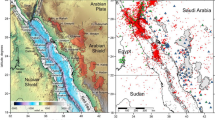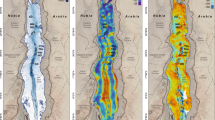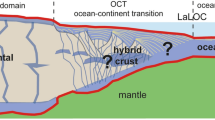Abstract
Seafloor spreading is largely unobserved because 98 per cent of the global mid-ocean-ridge system is below the ocean surface. Our understanding of the dynamic processes that control seafloor spreading is thus inferred largely from geophysical observations of spreading events on land at Afar in East Africa and Iceland1. However, these are slow-spreading centres1 influenced by mantle plumes2,3. The roles of magma pressure and tectonic stress in the development of seafloor spreading are still unclear. Here we use seismic observations to show that the most recent eruption at the fast-spreading East Pacific Rise just North of the Equator initiated at a melt-rich segment about 5 kilometres long4. The change in static stress then promoted almost-concurrent rupturing along at least 35 kilometres of the ridge axis, where tectonic stress had built up to a critical level, triggering magma movement. The location of impulsive seismic events indicative of lava reaching the seafloor5 suggests that lava subsequently erupted from multiple isolated6,7 magma lenses (reservoir chambers) with variable magma ascent rates, mostly within 48 hours. Therefore, even at magmatically robust fast-spreading ridges, a substantial portion of the spreading may be due to tectonic stress building up to a critical level rather than magma overpressure in the underlying magma lenses.
This is a preview of subscription content, access via your institution
Access options
Subscribe to this journal
Receive 51 print issues and online access
$199.00 per year
only $3.90 per issue
Buy this article
- Purchase on Springer Link
- Instant access to full article PDF
Prices may be subject to local taxes which are calculated during checkout




Similar content being viewed by others
References
Wright, T. J. et al. Geophysical constraints on the dynamics of spreading centres from rifting episodes on land. Nat. Geosci. 5, 242–250 (2012).
Ebinger, C. J. & Sleep, N. H. Cenozoic magmatism throughout east Africa resulting from impact of a single plume. Nature 395, 788–791 (1998).
Wolfe, C. J., Bjarnason, I. T. H., Vandecar, J. C. & Solomon, S. C. Seismic structure of the Iceland mantle plume. Nature 385, 245–247 (1997).
Xu, M. et al. Variations in axial magma lens properties along the East Pacific Rise (9° 30‘N-10°00’N) from swath 3-D seismic imaging and 1-D waveform inversion. J. Geophys. Res. 119, 2721–2744 (2014).
Wilcock, W. S. D., Tolstoy, M., Garcia, C., Tan, Y. J. & Waldhauser, F. Live from the seafloor: seismic signals associated with the 2015 eruption of Axial Seamount. Eos OS41B–07 (2015).
Carbotte, S. M. et al. Fine-scale segmentation of the crustal magma reservoir beneath the East Pacific Rise. Nat. Geosci. 6, 866–870 (2013).
Goss, A. R. et al. Geochemistry of lavas from the 2005–2006 eruption at the East Pacific Rise, 9° 46‘N-9° 56’N: implications for ridge crest plumbing and decadal changes in magma chamber compositions. Geochem. Geophys. Geosyst. 11, Q05T09 (2010).
Tolstoy, M. Mid-ocean ridge eruptions as a climate valve. Geophys. Res. Lett. 42, 1346–1351 (2015).
Dziak, R. P. et al. Rapid dike emplacement leads to eruptions and hydrothermal plume release during seafloor spreading events. Geology 35, 579–582 (2007).
Abdallah, A. et al. Relevance of Afar seismicity and volcanism to the mechanics of accreting plate boundaries. Nature 282, 17–23 (1979).
Einarsson, P. & Brandsdóttir, B. Seismological evidence for lateral magma intrusion during the July 1978 deflation of the Krafla volcano in NE Iceland. J. Geophys. 47, 160–165 (1980).
Ayele, A. et al. September 2005 mega-dike emplacement in the Manda-Harrano nascent oceanic rift (Afar depression). Geophys. Res. Lett. 36, L20306 (2009).
Sigmundsson, F. et al. Segmented lateral dyke growth in a rifting event at Bárðarbunga volcanic system, Iceland. Nature 517, 191–195 (2014).
Dziak, R. P. et al. January 2006 seafloor-spreading event at 9°50’N, East Pacific Rise: ridge dike intrusion and transform fault interactions from regional hydroacoustic data. Geochem. Geophys. Geosyst. 10, Q06T06 (2009).
Haymon, R. M. et al. Volcanic eruption of the mid-ocean ridge along the East Pacific Rise crest at 9°45–52’N: direct submersible observations of seafloor phenomena associated with an eruption event in April, 1991. Earth Planet. Sci. Lett. 119, 85–101 (1993).
Tolstoy, M. et al. A sea-floor spreading event captured by seismometers. Science 314, 1920–1922 (2006).
Soule, S. A., Fornari, D. J., Perfit, M. R. & Rubin, K. H. New insights into mid-ocean ridge volcanic processes from the 2005–2006 eruption of the East Pacific Rise, 9° 46‘N-9° 56’N. Geology 35, 1079–1082 (2007).
Fundis, A. T., Soule, S. A., Fornari, D. J. & Perfit, M. R. Paving the seafloor: Volcanic emplacement processes during the 2005–2006 eruptions at the fast spreading East Pacific Rise, 9°50’N. Geochem. Geophys. Geosyst. 11, Q08024 (2010).
Rubin, K. H. et al. Volcanic eruptions in the deep sea. Oceanography (Wash. D.C.) 25, 142–157 (2012).
Rubin, K. H., Macdougall, J. D. & Perfit, M. R. 210Po–210Pb dating of recent volcanic eruptions on the sea floor. Nature 368, 841–844 (1994).
Schlindwein, V., Muller, C. & Jokat, W. Seismoacoustic evidence for volcanic activity on the ultraslow spreading Gakkel Ridge, Arctic Ocean. Geophys. Res. Lett. 32, L18306 (2005).
Vergniolle, S., Brandeis, G. & Mareschal, J. C. Strombolian explosions. 2. Eruption dynamics determined from acoustic measurements. J. Geophys. Res. 101, 20449–20466 (1996).
Perfit, M. R. et al. Interaction of sea water and lava during submarine eruptions at mid-ocean ridges. Nature 426, 62–65 (2003).
Gregg, T. K. P., Fornari, D. J., Perfit, M. R., Haymon, R. M. & Fink, J. H. Rapid emplacement of a mid-ocean ridge lava flow on the East Pacific Rise at 9°46′-51’N. Earth Planet. Sci. Lett. 144, E1–E7 (1996).
Buck, W.R. On the frequency of dike intrusion episodes at spreading centers. Eos T41B–1566 (2006).
Chouet, B. A. Long-period volcano seismicity: its source and use in eruption forecasting. Nature 380, 309–316 (1996).
Canales, J. P. et al. Network of off-axis melt bodies at the East Pacific Rise. Nat. Geosci. 5, 279–283 (2012).
Bohnenstiehl, D. R. & Carbotte, S. M. Faulting patterns near 19°30’S on the East Pacific Rise: fault formation and growth at a superfast spreading center. Geochem. Geophys. Geosyst. 2, 1056 (2001).
Buck, W. R., Einarsson, P. & Brandsdottir, B. Tectonic stress and magma chamber size as controls on dike propagation: constraints from the 1975–1984 Krafla rifting episode. J. Geophys. Res. 111, B12404 (2006).
Marjanović, M. et al. A multi-sill magma plumbing system beneath the axis of the East Pacific Rise. Nat. Geosci. 7, 825–829 (2014).
Fornari, D. et al. in The Thermal Structure of the Ocean Crust and the Dynamics of Hydrothermal Circulation Vol. 148, 187–218 (AGU Geophys. Monogr., American Geophysical Union, 2004).
White, S. M., Haymon, R. M. & Carbotte, S. A new view of ridge segmentation and near-axis volcanism at the East Pacific Rise, 8°-12°N, from EM300 multibeam bathymetry. Geochem. Geophys. Geosyst. 7, Q12O05 (2006).
Munk, W. H., Worcester, P. & Wunsch, C. The forward problem: range-independent. Ocean Acoust. Tomogr . 30–114 (1995).
Gibbons, S. J. & Ringdal, F. The detection of low magnitude seismic events using array-based waveform correlation. Geophys. J. Int. 165, 149–166 (2006).
Lomax, A., Michelini, A. & Curtis, A. Earthquake location, direct, global-search methods in Encyclopedia of Complexity and System Science Vol. 1, 2449–2473 (Springer, 2009).
Waldhauser, F. & Ellsworth, W. L. A double-difference earthquake location algorithm: Method and application to the Northern Hayward Fault, California. Bull. Seismol. Soc. Am. 90, 1353–1368 (2000).
Waldhauser, F. & Tolstoy, M. Seismogenic structure and processes associated with magma inflation and hydrothermal circulation beneath the East Pacific Rise at 9°50’N. Geochem. Geophys. Geosyst. 12, Q08T10 (2011).
Bohnenstiehl, D. R., Waldhauser, F. & Tolstoy, M. Frequency-magnitude distribution of microearthquakes beneath the 9°50’N region of the East Pacific Rise, October 2003 through April 2004. Geochem. Geophys. Geosyst. 9, Q10T03 (2008).
Gottschämmer, E. & Surono, I. Locating tremor and shock sources recorded at Bromo Volcano. J. Volcanol. Geotherm. Res. 101, 199–209 (2000).
Saal, A. E., Hauri, E. H., Langmuir, C. H. & Perfit, M. R. Vapour undersaturation in primitive mid-ocean-ridge basalt and the volatile content of Earth’s upper mantle. Nature 419, 451–455 (2002).
Shinohara, H. Excess degassing from volcanoes and its role on eruptive and intrusive activity. Rev. Geophys. 46, RG4005 (2008).
Soule, S. A. et al. CO2 variability in mid-ocean ridge basalts from syn-emplacement degassing: constraints on eruption dynamics. Earth Planet. Sci. Lett. 327-328, 39–49 (2012).
Acknowledgements
Y.J.T. thanks W. R. Buck for discussions and reading of the manuscript. Y.J.T. thanks A. H. Barclay and R. S. Matoza for discussions. We thank R. P. Dziak and D. R. Bohnenstiehl for providing the T-wave earthquake catalogue. We thank the captains, crews and science parties of the RV Knorr and RV Atlantis. This work was supported by NSF grant OCE-0961594.
Author information
Authors and Affiliations
Contributions
Y.J.T., advised by M.T. and F.W., analysed the seismic data and wrote the manuscript. M.T. and F.W. conceived and ran the experiment. W.S.D.W.’s identification of impulsive lava signals at Axial inspired this study. All authors discussed the results and commented on the manuscript.
Corresponding author
Ethics declarations
Competing interests
The authors declare no competing financial interests.
Additional information
Reviewer Information Nature thanks J. Karson and V. Schlindwein for their contribution to the peer review of this work.
Extended data figures and tables
Extended Data Figure 1 Impulsive lava event signals.
a, b, Velocity seismograms of the same event recorded at two different stations. The difference in station relative arrival time of >1 s for the first arrival suggests a waterborne arrival (that is, the seismic wave travelled through the water column rather than through the crust), since these stations are around 2 km apart, with water velocity being 1.5 km s−1 and P-wave crustal velocity being around 4–5 km s−1 (ref. 37). The event also has multiple arrivals: the first arrival represents a signal that has bounced off the sea surface once (B1) and the second arrival represents a signal that has bounced off the sea surface twice (B2) (Extended Data Fig. 2b). c, The signal shows a dominant frequency of about 22 Hz.
Extended Data Figure 2 Impulsive lava events.
a, Location of seismometers (yellow triangles) and impulsive lava events in the first hour (red), first two days (pale red), and last five days (dark red). The AST17 is shown as a thin blue line with green arrow marking its end. The bold black line marks revised 2006 lava flow farther off-axis than originally identified18. AML disruptions (purple arrows) were inferred from seismic reflection studies post-eruption6.b, Histogram of hourly impulsive lava event rate. The red line shows hourly average impulsive lava event magnitude. Mid-ocean-ridge basalt on the East Pacific Rise has been found to have low volatile content40. Therefore, the larger-magnitude impulsive lava events during the first 5 h might be driven by excess degassing of volatiles from a larger reservoir of unerupted magma41, consistent with the estimate that <15% of the available magma in the AML was erupted17. The lava has also been suggested to have degassed from supersaturated conditions owing to a rapid magma ascent rate from depth42. The breaks in the red line are due to hours when there are no events located, and hence no average magnitude data point. Event magnitudes were calculated as the logarithm of the displacement (in micrometres) multiplied by the signal travel distance (in kilometres), which is different from earthquake magnitude. The inset shows the model of the signal travel path used in locating the impulsive lava events (VW is the velocity of the seismic wave travelling through the water column). A direct waterborne arrival is not recorded, probably because of the upward refraction of energy due to increasing velocity with water depth. The lack of crustal arrival indicates a small absolute magnitude.
Extended Data Figure 3 Earthquake locations.
The A–A′ depth slice shows a 1-km-thick east-southeast (ESE)-dipping structure towards the ridge axis. The B–B′ depth slice shows that the structure is subvertical in this direction (that is, north-northeast to south-southwest, NNE–SSW) with a width of around 500 m. Earthquakes occurred between 13:30 and 20:00 on 22 January 2006, mostly in the first two hours. The 50 largest-magnitude earthquakes are highlighted with black circles.
Extended Data Figure 4 Local magnitude of earthquakes.
a, Earthquakes show increasing local magnitude ML with time in a two-hour period leading up to the eruption. Blue dots represent earthquakes during the eruption period analysed in this study in detail while black dots represent earthquakes over a longer period. b, An 8-h zoom-in on panel a, demonstrating a clear trend of increasing magnitude immediately before plate rupture.
Extended Data Figure 5 Lava flow velocities.
a, Location of seismometers (yellow triangles labelled with station numbers) and impulsive lava events (coloured dots) in the four flow lobes17 (thin black outline enclosing the lava flow). The bold black line marks the revised extent of the 2006 lava flow farther off-axis than originally identified18 (see legend to Fig. 1). b, c, Propagation of impulsive lava events off-axis in two flow lobes.
Extended Data Figure 6 Synthetic test of earthquake locations.
a–c, Actual locations of synthetic sources. d–f, Locations of synthetic sources with normally distributed noise of standard deviation 200 m added. These are used as the initial locations for double difference relocation. g–i, Relocated locations of synthetic sources. Events were relocated using synthetic arrival time with normally distributed noise of standard deviation 0.01 s added.
Extended Data Figure 7 Earthquake relative location errors.
Distribution of least-squares errors for the relative locations in longitudinal distance, latitudinal distance and depth.
Extended Data Figure 8 Long-period event locations.
a, Long-period event locations assuming 0 km depth (black dots) and 1.5 km depth (green stars), assuming a constant crustal velocity of 2.5 km s−1. The red line marks the extent of melt-depleted sub-AML30. Although location depth cannot be definitively determined, the 1.5-h time gap between the initiation of long-period events and melt reaching the surface strongly supports a deeper source. b, Long-period event locations assuming a constant crustal velocity of 2.5 km s−1 (green stars) and 2.9 km s−1 (black dots) assuming 1.5 km depth. Regardless of the depth and velocity used, events generally cluster near the western edge of the melt lens and bound the area of sub-AML depletion. Faint blue dots represent local earthquake locations (Fig. 1c) for reference.
Extended Data Figure 9 Long-period event velocity assumption.
Minimum of standard deviation for different guess (modelled) velocities, assuming a depth of 1.5 km. The overall minimum of the standard deviation occurs at a velocity of 2.5 km s−1.
Extended Data Figure 10 Waveforms of long-period events.
Waveforms of two separate events at all three stations low-pass filtered at 5 Hz. Red arrows mark the first arrivals. Both event signals arrived at stations S204 and S205 at the same time. This constrains the location of these events to the west of the ridge axis, between these two stations. The event to the south arrived first at S204 and S205 before S209. The event to the north arrived first at S209 followed by S204 and S205. This constrains the northward migration of the long-period events.
Rights and permissions
About this article
Cite this article
Tan, Y., Tolstoy, M., Waldhauser, F. et al. Dynamics of a seafloor-spreading episode at the East Pacific Rise. Nature 540, 261–265 (2016). https://doi.org/10.1038/nature20116
Received:
Accepted:
Published:
Issue Date:
DOI: https://doi.org/10.1038/nature20116
This article is cited by
-
Crustal Structure of the Jurassic Quiet Zone in the West Pacific Ocean: Insights from 2D Multichannel Seismic Reflection Profiles
Journal of Ocean University of China (2023)
-
Diversity of magmatism, hydrothermal processes and microbial interactions at mid-ocean ridges
Nature Reviews Earth & Environment (2022)
-
Microbial succession during the transition from active to inactive stages of deep-sea hydrothermal vent sulfide chimneys
Microbiome (2020)
-
Distributed sensing of microseisms and teleseisms with submarine dark fibers
Nature Communications (2019)
-
Petrology and geochemistry of the 2014–2015 Holuhraun eruption, central Iceland: compositional and mineralogical characteristics, temporal variability and magma storage
Contributions to Mineralogy and Petrology (2018)
Comments
By submitting a comment you agree to abide by our Terms and Community Guidelines. If you find something abusive or that does not comply with our terms or guidelines please flag it as inappropriate.



